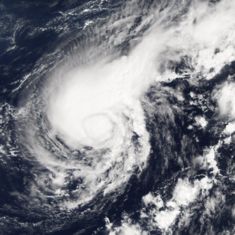Tropical Storm Harvey (2005)
2007 Schools Wikipedia Selection. Related subjects: Storms
| Tropical storm ( SSHS) | ||
|---|---|---|
|
Tropical Storm Harvey on August 4 |
||
| Formed | August 2, 2005 | |
| Dissipated | August 8, 2005 | |
| Highest winds |
|
|
| Lowest pressure | 994 mbar ( hPa) | |
| Damage | None reported | |
| Fatalities | None reported | |
| Areas affected |
Bermuda | |
| Part of the 2005 Atlantic hurricane season |
||
Tropical Storm Harvey was a strong tropical storm over the western Atlantic Ocean during August in the 2005 Atlantic hurricane season. Harvey was the eighth named storm of the record-breaking season.
Tropical Storm Harvey formed from a tropical wave to the southwest of Bermuda on August 2 and passed close to Bermuda on August 4, bringing heavy rain to the island. After it moved east away from Bermuda, Harvey reached its peak strength before the storm turned to the northeast. Harvey became a strong extratropical storm on August 8 and the system survived for a few more days in the central Atlantic.
Storm history
A tropical wave left the African coast on July 22 and crossed over the Atlantic without any development occurring. When the wave approached the Leeward Islands on July 28, the National Hurricane Centre monitored the system closely for any possible development, which did not occur at that time. By August 2, conditions had become more favorable and Tropical Depression Eight formed about 350 miles (595 km) southwest of Bermuda. The depression strengthened into Tropical Storm Harvey the next day. High initial levels of wind shear gave Harvey some subtropical characteristics and also caused the official forecasts to underestimate the future strength of the storm.
Harvey passed 45 miles (75 km) south of Bermuda early on August 4, with winds of 60 mph (90 km/h), before shedding its subtropical characteristics to become a "fully tropical" storm. As it moved northeast away from the island, the storm strengthened further to its peak with winds of 65 mph (100 km/h). Unexpectedly, increased wind shear did not cause Harvey to weaken significantly, although the storm's motion did become erratic. Harvey became a strong extratropical storm during the night on August 8 and survived another few days before dissipating northwest of the Azores on August 14.
Impact
As Tropical Storm Harvey approached Bermuda a tropical storm warning was issued late on August 2 and due to the outside possibility of further strengthening to hurricane strength a hurricane watch was issued 24 hours later. As the storm moved away from Bermuda on August 4, first the hurricane watch and then the tropical storm warning were cancelled.
Harvey brought heavy rain to Bermuda, with just over 5 inches (130 mm) reported at Bermuda International Airport and caused some flooding of roads. In addition, there was a report of sustained winds of approximately 45 mph (75 km/h) on the island. The storm was not responsible for any fatalities or damages on the island.
Naming and Records
When Tropical Storm Harvey formed on August 3, it was the earliest ever in a season that the eighth tropical storm formed, beating the previous record held by Hurricane Eight of the 1936 season by 12 days. This was the fourth time that the name Harvey had been used to name a tropical cyclone in the Atlantic and the sixth time worldwide. Due to the lack of any major effects from Tropical Storm Harvey, the name was not retired by the World Meteorological Organization and will be on the list of names for the 2011 Season.

